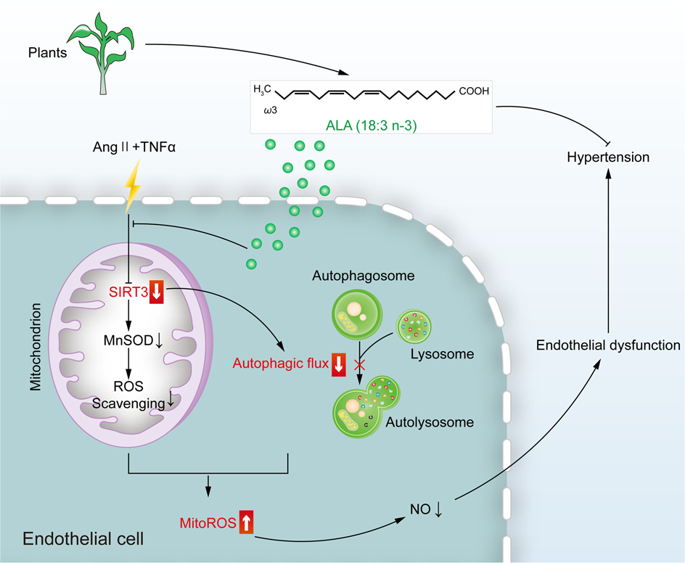当前位置:
X-MOL 学术
›
Cell Death Dis.
›
论文详情
Our official English website, www.x-mol.net, welcomes your
feedback! (Note: you will need to create a separate account there.)
α-Linolenic acid but not linolenic acid protects against hypertension: critical role of SIRT3 and autophagic flux.
Cell Death & Disease ( IF 8.1 ) Pub Date : 2020-02-03 , DOI: 10.1038/s41419-020-2277-7 Guohua Li 1 , Xinpei Wang 1 , Hongyan Yang 1 , Pengfei Zhang 1 , Fangqin Wu 1 , Yunchu Li 1 , Yingjie Zhou 1 , Xing Zhang 1 , Heng Ma 2 , Wei Zhang 3 , Jia Li 1
Cell Death & Disease ( IF 8.1 ) Pub Date : 2020-02-03 , DOI: 10.1038/s41419-020-2277-7 Guohua Li 1 , Xinpei Wang 1 , Hongyan Yang 1 , Pengfei Zhang 1 , Fangqin Wu 1 , Yunchu Li 1 , Yingjie Zhou 1 , Xing Zhang 1 , Heng Ma 2 , Wei Zhang 3 , Jia Li 1
Affiliation

|
Although dietary α-linolenic acid (ALA) or linolenic acid (LA) intake was reported to be epidemiologically associated with a lower prevalence of hypertension, recent clinical trials have yielded conflicting results. Comparable experimental evidence for the roles of these two different fatty acids is still lacking and the underlying mechanisms need to be further elucidated. Our data showed that ALA but not LA supplementation alleviated systolic blood pressure elevation and improved ACh-induced, endothelium-dependent vasodilation in both spontaneously hypertensive rats (SHRs) and AngII-induced hypertensive mice. In addition, SHRs displayed reduced vascular Sirtuin 3 (SIRT3) expression, subsequent superoxide dismutase 2 (SOD2) hyperacetylation and mitochondrial ROS overproduction, all of which were ameliorated by ALA but not LA supplementation. In primary cultured endothelial cells, ALA treatment directly inhibited SIRT3 reduction, SOD2 hyperacetylation, mitochondrial ROS overproduction and alleviated autophagic flux impairment induced by AngII plus TNFα treatment. However, these beneficial effects of ALA were completely blocked by silencing SIRT3. Restoration of autophagic flux by rapamycin also inhibited mitochondrial ROS overproduction in endothelial cells exposed to AngII plus TNFα. More interestingly, SIRT3 KO mice developed severe hypertension in response to a low dose of AngII infusion, while ALA supplementation lost its anti-hypertensive and endothelium-protective effects on these mice. Our findings suggest that ALA but not LA supplementation improves endothelial dysfunction and diminishes experimental hypertension by rescuing SIRT3 impairment to restore autophagic flux and mitochondrial redox balance in endothelial cells.
中文翻译:

α-亚麻酸而非亚麻酸可以预防高血压:SIRT3 和自噬流的关键作用。
尽管据报道饮食中α-亚麻酸(ALA)或亚麻酸(LA)的摄入量在流行病学上与较低的高血压患病率相关,但最近的临床试验却得出了相互矛盾的结果。这两种不同脂肪酸的作用仍缺乏可比的实验证据,其潜在机制需要进一步阐明。我们的数据显示,在自发性高血压大鼠 (SHR) 和 AngII 诱导的高血压小鼠中,ALA(而非 LA)补充剂可缓解收缩压升高,并改善 ACh 诱导的内皮依赖性血管舒张。此外,SHR 还表现出血管 Sirtuin 3 (SIRT3) 表达减少、随后的超氧化物歧化酶 2 (SOD2) 过度乙酰化和线粒体 ROS 过量产生,所有这些都可以通过 ALA 得到改善,但补充 LA 却没有改善。在原代培养的内皮细胞中,ALA 处理直接抑制 SIRT3 减少、SOD2 过度乙酰化、线粒体 ROS 过量产生,并减轻 AngII 加 TNFα 处理引起的自噬流损伤。然而,ALA 的这些有益作用被沉默 SIRT3 完全阻断。雷帕霉素恢复自噬流也抑制了暴露于 AngII 加 TNFα 的内皮细胞中线粒体 ROS 的过量产生。更有趣的是,SIRT3 KO 小鼠在低剂量 AngII 输注后出现严重高血压,而 ALA 补充剂则失去了对这些小鼠的抗高血压和内皮保护作用。我们的研究结果表明,补充 ALA(而非 LA)可以通过挽救 SIRT3 损伤来恢复内皮细胞的自噬流和线粒体氧化还原平衡,从而改善内皮功能障碍并减少实验性高血压。
更新日期:2020-02-03
中文翻译:

α-亚麻酸而非亚麻酸可以预防高血压:SIRT3 和自噬流的关键作用。
尽管据报道饮食中α-亚麻酸(ALA)或亚麻酸(LA)的摄入量在流行病学上与较低的高血压患病率相关,但最近的临床试验却得出了相互矛盾的结果。这两种不同脂肪酸的作用仍缺乏可比的实验证据,其潜在机制需要进一步阐明。我们的数据显示,在自发性高血压大鼠 (SHR) 和 AngII 诱导的高血压小鼠中,ALA(而非 LA)补充剂可缓解收缩压升高,并改善 ACh 诱导的内皮依赖性血管舒张。此外,SHR 还表现出血管 Sirtuin 3 (SIRT3) 表达减少、随后的超氧化物歧化酶 2 (SOD2) 过度乙酰化和线粒体 ROS 过量产生,所有这些都可以通过 ALA 得到改善,但补充 LA 却没有改善。在原代培养的内皮细胞中,ALA 处理直接抑制 SIRT3 减少、SOD2 过度乙酰化、线粒体 ROS 过量产生,并减轻 AngII 加 TNFα 处理引起的自噬流损伤。然而,ALA 的这些有益作用被沉默 SIRT3 完全阻断。雷帕霉素恢复自噬流也抑制了暴露于 AngII 加 TNFα 的内皮细胞中线粒体 ROS 的过量产生。更有趣的是,SIRT3 KO 小鼠在低剂量 AngII 输注后出现严重高血压,而 ALA 补充剂则失去了对这些小鼠的抗高血压和内皮保护作用。我们的研究结果表明,补充 ALA(而非 LA)可以通过挽救 SIRT3 损伤来恢复内皮细胞的自噬流和线粒体氧化还原平衡,从而改善内皮功能障碍并减少实验性高血压。





















































 京公网安备 11010802027423号
京公网安备 11010802027423号